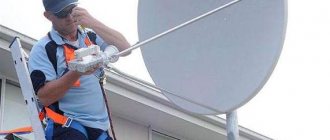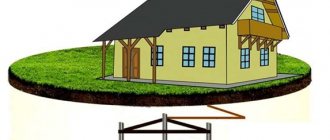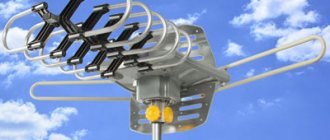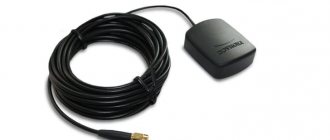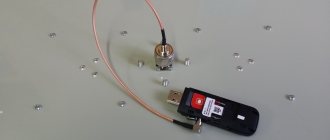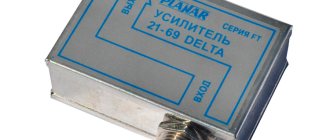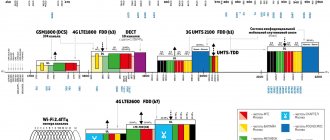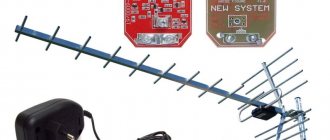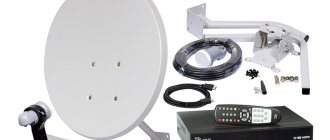Although installing an antenna on the roof of a house is fraught with difficulties, the roof still remains the optimal place for installing satellite dishes and television and Internet signal amplifiers. On the roof, the antenna is not interfered with by the building walls, eaves and gable overhangs, so it can be accurately aimed and get the best signal quality. Moreover, you don’t always have to pay for a high-quality signal by violating the integrity of the roofing pie - in addition to the standard fastening of antenna masts to rafters and guy wires, there are several ways to fix a satellite dish, television “grid” or panel antenna to amplify the 3G/4G signal without holes in roof.
But we will start not with a description of mounting methods, but with what legal consequences an incorrectly installed antenna on the roof of a house can lead to.
Installation instructions
Room
This option is the easiest to install. As a rule, it is enough to unpack it, unfold it, connect it to a TV or receiver, and you can watch programs. However, there are subtleties that must be taken into account:
- Indoor models typically have low gain. Therefore, they can only be used where the TV signal from the repeater is strong enough.
- For the UHF range in which digital television broadcasts, the walls of the house may turn out to be opaque. It is preferable to place a decimeter antenna in a window opening or on a loggia.
- For normal reception, it must be oriented towards the repeater tower from which the broadcast is coming. You can determine the direction in 1 minute using the RTRS online map.
Important! There is no structural difference between indoor and outdoor. Many indoor models can be used as outdoor ones with minimal modifications (for example, waterproofing electronic components and cable soldering points).
Outdoor
A more effective option for an individual antenna is an external one. Installation is more complicated, but it provides better reception.
Fastening to the facade
The easiest way is to install an outdoor TV antenna on a special bracket on the wall of the house facing the repeater.
The installation location must be selected taking into account the following points:
- the maximum possible height - this reduces the likelihood that there will be some kind of obstacle in the signal path;
- There should be no objects between the TV antenna and the repeater that absorb or reflect the signal. This could be a neighboring building, a metal fence or roof, dense thickets of tall trees, hills, etc.;
- The design of the bracket must allow for precise orientation of the antenna to the tower.
It is best to place the antenna in the following places:
- On the wall next to the window.
This option is most often used in urban apartment buildings. In this case, mounting the bracket and adjusting the TV antenna in direction is quite safe and does not require the use of lifts or equipment for industrial mountaineering. - On the wall under the roof.
This is how antennas are usually mounted in private houses and country cottages. Make sure that the roof itself does not “shade” the TV signal. If the roof is covered, for example, with galvanized sheets or tiles with a metal base, it will reflect and absorb the ethereal signal. - On the loggia.
If the windows face the desired direction, the antenna can be placed on the balcony. If the signal from the repeater is strong enough, you can mount it not on an external, but on an internal wall: the glazing does not interfere too much with the signal, and the antenna itself in this case will be protected from wind and precipitation.
Fastening to aerated concrete or silicate blocks must be done using special anchors: these materials crumble easily.
The procedure for installing an external antenna in this case will be as follows:
- Choose a place where it will be attached. The combination of both the height of the location and the distance to the TV receiver is important here: a cable that is too long will weaken the signal.
- Install the bracket on the wall.
It can be secured in different ways: using dowels, bolts, self-tapping screws with plugs, etc. The main thing is to ensure a strong connection: the TV antenna should not move under the influence of gusts of wind. Minimize the risk of the bracket coming off and falling along with the entire structure. - Fasten "in rough."
Use the clamp that comes with the kit, or purchase a similar one. At this stage, it should be possible to rotate the antenna to fine-tune it to the TV tower. - Adjust the direction. Carefully move it horizontally, pointing it at the repeater. Perform manipulations until the maximum signal level is reached.
- Fasten it tightly. Make sure it is securely fixed so that the structure does not move due to the wind, the weight of snow, etc.
Important! For broadcasting in the DVB-T2 format, horizontal polarization of electromagnetic waves is used. Therefore, the TV antenna must be fixed clearly horizontally, without displacement. If you try to rotate it 90°, reception will most likely stop.
Installation on the roof of an apartment building
In the city, the best option, especially for residents of upper floors, is to place the antenna on the roof. However, you must immediately take into account the following:
- It is always windy on the roof of a multi-story building. Therefore, the antenna itself should not be too “saily” (so that it does not blow away), and the fastenings should be reliable.
- It is strictly forbidden to install a TV antenna at a distance of less than 3 meters from the parapet, chimneys and ventilation shaft exits - this is a safety requirement.
- The minimum distance to other installed antennas must be more than 3 m.
- When choosing an installation location, you must assume that the structure may fall. When tipping over there should be no threat of damage to communications and adjacent antennas. Eliminate the possibility of the structure falling on the heads of passers-by, place the TV antenna closer to the courtyard area - fewer people walk there.
- It takes two people to work on the roof. It is highly desirable - with insurance (at least with a banal rope wrapped around the belt and secured to a solid structure).
Types of antennas and features of their installation
An antenna is a device that receives a weak signal and amplifies it. The shape and dimensions of the antenna depend on the type of signal.
TV antenna
The most common type of antenna. Most often, a television antenna looks like a long rod with tubes that are inserted at a certain pitch. They can be either passive or active, with an amplifier installed on them. Unlike cellular base stations, which work both to receive and transmit, television towers only distribute the signal, so antennas with amplifiers do not interfere with their operation.
For installation on the roof, it is better to buy a “wave channel” or log-periodic antenna. They are made from relatively thick steel tubes, so they do not deform even when exposed to strong winds. It is not recommended to install various types of antenna arrays on the roof - thin twigs are easily bent even by a bird landing on them, not to mention the wind, so the antenna will have to be regularly repaired or replaced.
Since Russian TV towers have completely switched to broadcasting using the DVB-T2 standard since 2022, completely turning off analogue over-the-air channels, digital antennas are being installed on the roofs of private houses to receive the signal. They are installed on special masts, the height of which depends on the terrain, as well as the distance from the television tower. As a rule, for stability, the masts are fixed to the roof with guy wires, and if the height is more than three meters, with two rows of guy wires.
Satellite antenna
This is a characteristic “plate” that can often be found on the roof of private houses. Thanks to its semicircular shape, the satellite dish on the roof of the house seems to collect a signal from the satellite and focus it on the converter. Moreover, the larger the “dish” area, the better it focuses the signal. However, with increasing diameter, a satellite dish on the roof better catches not only the signal, but also the wind, so when choosing its size, you should not get too carried away: for each satellite there is a coverage map, which indicates the transmit power in dBW and the recommended antenna diameter depending on power values. For example, for the Express AM 22 53.0°E satellite, the coverage map and satellite dish size table looks like this:
In order for the satellite television image to be of high quality not only on a clear day, but also in the rain, it is better to take a dish that is designed for lower power. A reserve of 2-3 units of power is considered optimal. This means that with a signal power of 46 dBW, it is better to buy a roof antenna with a diameter of 1.34-1.5 m rather than 1.07 m.
In addition to the size, you need to take into account the design and material from which the satellite dish is made.
Depending on the shape of the dish, antennas for domestic use are:
- Offset . Offset satellite antennas are elongated into an ellipse and reflect the signal with a downward shift, which allows them to be installed almost vertically.
- Direct focus . Direct focus satellite antennas have a round reflective surface, so the converter is placed in the center. For this reason, they are larger than offset satellite dishes, and they are installed at a fairly large angle to the horizon.
- Toroidal . A modern type of satellite antenna, which consists of two reflectors installed opposite. Due to the specific curved shape of the small mirror, up to 16 converters can be installed on a toroidal antenna.
Now let’s talk about which of the listed satellite dishes are best suited for installation on the roof. The standard solution is offset satellite dishes, on which almost no snow accumulates in winter. An advanced option is toroidal satellite dishes. But they are expensive, and they only make sense if you need to receive a signal from 4-5 or more satellites at once. Installing a direct-focus type satellite antenna on the roof is not recommended, since whole snowdrifts grow on the mirror turned to the sky in winter, which interfere with signal reception, even completely blocking it, and create a significant additional load on the rafter system.
As for materials, satellite dishes are made of steel, aluminum, and even plastic.
Steel plates are the cheapest, but over time they begin to rust, which affects the quality of the image and, more importantly, the reliability of their fastening - corrosion usually begins at the edges and near the mounting holes.
Aluminum satellite dishes are more expensive, but they are practically not subject to corrosion - when oxidized, the aluminum is covered with a thin film that protects the metal from further destruction. But they require a special bracket for attaching the antenna to the roof: aluminum is light and not the strongest metal, so the dish can simply be torn off the roof by a strong wind. To prevent this from happening, larger area fasteners are used for aluminum antennas.
Plastic satellite dishes have appeared on the market relatively recently. Apart from price, plastic dishes have no special advantages - they weigh even less than aluminum antennas and are not subject to corrosion, but the reflective surface of plastic wears off quite quickly, and its strength leaves much to be desired. Therefore, plastic satellite dishes are more of a travel option. They cannot be placed on the roof.
Antenna for strengthening the signal of cellular communications and mobile Internet
3G/4G and GSM antennas come in three types:
- Omnidirectional antennas . They have minimal gain, but they do not need to be precisely positioned.
- Panel antennas . When installing an antenna in a private home, panel structures are usually used - they are universal, and, depending on the model, can receive a signal at a distance of 5 to 25 km from the base station. Some models support MIMO technology.
- Directional antennas of the "wave channel" type . They look almost the same as television ones, only the metal tubes on the central rod are installed at a different pitch. They receive a signal at a distance of 20-25 km from the base station.
- Directional parabolic antennas . They can pick up a signal at the greatest distance - 25-30 km, and at high altitudes and without interference - up to 40 km. But they are difficult to position - it is important to point the antenna exactly at the base station.
For a private home, it is better to buy panel-type antennas. They are compact and easier to mount on the roof. If the house is built in the wilderness or there are sources of strong interference near it, then choose directional antennas. Omnidirectional structures are used in urban areas because they receive the reflected signal well.
Choosing a cable, where and how best to pull it
A significant element when installing an antenna is the cable. Regarding this, please follow these recommendations:
- All standard coaxial cables for television must have a characteristic impedance of 75 ohms.
- For a cable, the price-quality ratio is important. The preferred options are the Russian-Chinese RG-6, Russian RK-75, Italian SAT-50, SAT-703 or DG-113. RG-59 is not recommended: the signal loss is too high, and the cable itself is fragile and cannot withstand sharp bends.
To ground or not
If, as a result of installation, the antenna turns out to be the highest point within a radius of 50 m, there must certainly be grounding.
If a lightning rod is present, you should still think about grounding for safety reasons.
It is important to observe the following safety precautions:
- power outage throughout the house during a thunderstorm;
- disconnecting an antenna of any format during a thunderstorm;
- Grounding must be carried out in accordance with electrical safety standards.
Quality fine tuning
After the antenna is installed, its fine tuning is necessary, since its operation is influenced by a number of factors:
- Interference from operating devices. For example, interference from Wi-Fi and microwave ovens is strong.
- Orientation accuracy. Long-distance antennas require adjustment to within a degree.
- Direct and reflected signal strength, etc.
To fine-tune, you need to perform the following steps:
- Smoothly and carefully change the orientation of the antenna in the horizontal plane. The transmitted TV signal is polarized parallel to the ground, so it is extremely important to adhere to this plane.
- Measure the signal level after each correction.
You can get rid of interference in the following ways:
- raise the TV antenna so that it is out of the zone of influence of spurious signals;
- orient it as accurately as possible;
- tune the receiver to the exact CETV broadcast frequency;
- connect an amplifier if necessary.
How to install an antenna for digital television in a private home
What types of antennas are there for digital TV?
To receive a digital dvb t2 signal at the dacha, the following types of television antennas are available:
- Indoor . They are used if the repeater is located nearby. As options, room units with a signal amplifier are available.
- External passive . Installed outdoors to receive a digital signal and transmit it via cable to the receiver. Sometimes a filter is installed on it to eliminate reception interference.
- Outdoor active . An antenna with a built-in amplifier is used to receive a weak signal. It receives a UHF signal, amplifies it and transmits it further to the TV.
Directionality is very important for the quality of digital television reception. The clarity of the resulting image depends on this. Based on this feature, devices are divided into narrow-directional and broad-directional.
In a country house or country house, it is better to install active antennas for digital television with a signal amplifier, since due to the long distance to the TV tower, the signal strength is weak.
How to choose?
- Indoor or outdoor? For a dacha, only the last type is needed. This is due to the significant remoteness of the site; it is necessary to think about alternatives only if a repeater is located nearby. Outdoor is superior to indoor in all respects. With her the reception is more confident. The only drawback is that its installation will require significant effort and certain experience from the performer.
- Active or passive? For a dacha, it doesn’t really matter what type of device it is. A classic external antenna is equipped with a cable and a box in which a matching board is installed. Such a device does not have active amplification elements powered by electricity. This is its advantage and disadvantage, since this is often what is missing for a confident reception. A receiver is called active if it is equipped with an amplifier with a power supply.
- Signal. Digital terrestrial television requires DVB T2 support. Even the cheapest models operating in the DMB range can effectively cope with this task. The level allows you to determine performance indicators in digital format. In order to determine its value, you need to open the corresponding item in the receiver menu. Quality is a parameter that determines the effectiveness of the reception. If the level and quality indicators are too low, it is recommended to change the location of the antenna, or raise it higher. When setting up, it is rotated in different directions to achieve the most acceptable results for viewing. The direction is determined by the location of the repeater. Negative natural conditions affect the received signal. This is especially true for strong winds, snowfall, and heavy rains.
- Gain. The indicator is measured in decibels. With its help, a weak wave signal is increased. This does not mean that the resulting picture will be of good quality. The higher the ratio, the better.
- Assembly. Before purchasing, please read the instructions. We must not forget that the signal receiver still needs to be assembled. Machine translation, many errors and inaccuracies serve as a signal that it is better to refuse such a product. In addition, it is necessary to visually inspect the parts for their integrity and assembly quality. If their quality does not inspire confidence, it is better to refrain from purchasing.
Legal formalities
When installing an antenna on the roof of apartment buildings, you must additionally:
- Coordinate the installation with the management company or HOA. And in cases specified by law - with other residents and the local administration (for example, if the house is classified as an architectural monument, where external alterations are prohibited and a separate permit for installation must be obtained).
- Gain physical access to the attic space and roof. According to the Civil Code and Housing Code of the Russian Federation, apartment owners have the right to use common property. Therefore, even if the attic is locked, you need to get a key from the management company or housing office. The apartment owner has no right to refuse.
Important! If the HOA, management company or other company interferes with the installation, then these actions can be safely appealed in court.
What is the penalty for unauthorized installation?
Responsibility for violation of the specified rules for maintaining common property in an apartment building is provided for in Art. 7.22 of the Code of the Russian Federation on Administrative Offenses (CAO): this is the imposition of an administrative fine on officials in the amount of 4,000 to 5,000 rubles, on legal entities - from 40,000 to 50,000 rubles. At the same time Art. 7.21 of the Code of Administrative Offenses provides for the responsibility of the owner of the premises for unauthorized redevelopment or re-equipment. Unauthorized redevelopment entails the imposition of an administrative fine on citizens in the amount of 2,000 to 2,500 rubles.
Mast mounting methods
There are several ways to mount a television antenna mast on the roof of a house:
Method 1. Fastening with brackets to a brick chimney pipe and ventilation. Installation is carried out using brackets with clamps, which are attached to the wall with anchor bolts.
Where: 1 – mast; 2 – bracket with clamp; 3 – brick chimney and ventilation pipe; 4- anchor bolt; 5 - outdoor antenna.
Method 2. Installation of the mast on the ceiling with fastening to the roof structure elements.
1 — receiving antenna device; 2 – mast; 3 — clamp for fastening the mast to the roof structure; 4 - rafter beam.
In this case, the base of the mast must be installed on the ceiling slab in the attic of the house. The mast is attached with a clamp to the wooden roof structure; for this purpose it is best to use rafter beams.
Method 3. Installation of a mast with fastening using guy wires. If it is not possible to secure the mast to the roof structures, you can use its fastening using guy wires or steel cable. To do this, it is necessary to equip the mast with lugs located in the upper part of the mast structure.
Cabling
After installing the receiving antenna device, it is very important to secure the cable correctly and securely. It must be laid and secured in such a way as to minimize the impact of wind, snow sliding from the roof and streams of rainwater. The cable is fastened evenly along the entire length of the mast using clamps at intervals of 50 centimeters, then it is laid along the roof ridge and in the area of the window through which it will be inserted into the house, it is lowered down. At this point the cable must be secured with a bracket. It is first necessary to drill a hole in the window frame with a diameter slightly larger than the size of the conductor. In order to prevent precipitation from entering through the gap in the hole, it must be drilled with an appropriate angle; it would be better if it is possible to seal it with waterproof silicone. Be sure to allow a slight slack in the cable before entering the frame; this is necessary to compensate for temperature expansion.
The installation must be carried out carefully, observing the established technical requirements. The bending radius of the cable should not be less than five of its diameters; when applying fastening brackets, try to avoid squeezing the sheath.
Grounding
Do I need to ground an outdoor antenna? Theoretically, if there is no lightning rod on a personal plot, this safety measure is necessary. In the event of a lightning strike, the grounded antenna device will operate in lightning rod mode, saving the TV from fire. At the same time, experts are of the opinion that there is no particular need for grounding antennas, given that most people do not watch TV during a thunderstorm while removing the cable plug from the antenna socket.
Grounding diagram for a television antenna and mast:
We talked about how to make a lightning rod with your own hands in a separate article. The instructions for installing a grounding loop in a house were also described in detail earlier.
Now you know how to install an antenna on the roof of a private house. We hope that our step-by-step instructions, with photos and video examples, were useful and interesting for you!
Choosing installation on the facade
One of the easiest installation options. This installation is easy to do yourself, but there is a significant disadvantage.
For better reception, the signal from the repeater must be of high power so that the device does not need to be raised high.
It is important to pay attention to what the walls of the house are made of. If the walls are made of brick or wood, this installation option is best suited.
The distance between fasteners should be no more than one and a half meters. For fasteners, use self-tapping screws or bolts.
In this diagram, number one is the antenna receiver, number two is a metal beam or pipe, number three is a bracket, and number four is a self-tapping screw or bolt.
In life it looks like this:
In the following video you can see how the installation takes place in this installation option:
Don’t forget that you can make such an antenna yourself, saving significantly on the purchase of the device.
Types of antennas for the roof of a house ↑
- Multi-wave. Most often, this is a system of compiled receiving devices, all of which are capable of receiving waves of a specific range. Such a device looks like a metal pole, on the top of which there is a receiving device. To ensure stable signal reception, the pole sometimes needs to be quite high. Since under these conditions the stability of the structure is at risk, it is equipped with guy wires.
In connection with the full-scale transition to digital television broadcasting, UHF devices have become in great demand. However, the TV must also be equipped with a special digital receiver. If you don’t have one, you will have to buy a similar set-top box that connects to the TV.
- Satellite dishes. Today you can see plates everywhere on roofs: white, mesh and others. Houses in rural areas are no exception in this matter. They differ greatly in their diameter: the larger the dish, the higher their ability to receive signals from the satellite.
They come in several types:
- direct focus. Designed to receive distant satellites, the diameter of the dish is offset. Effective in relatively small sizes, they receive signals from many transmitting satellites. multifocal. This is one of the varieties of offset. They are capable of receiving a large number of satellites and providing high quality. The most famous in this category is the toroidal antenna.
There are plates made from different materials on the market.
- The most affordable, but least resistant to precipitation, are made of sheet steel. Plastic - although resistant to corrosion, they cannot withstand temperature changes. Aluminum - less susceptible to corrosion than steel, but not resistant to deformation. Perforated metal ones are more resistant to wind, but in the KU range there may be a loss of signal strength.
Necessary equipment
There are several digital broadcasting standards. In the Russian Federation it is DVB-T2. The list of necessary equipment to search for free TV channels varies depending on the equipment already available. However, there are several generally accepted devices that you cannot do without.
1. UHF antenna for receiving digital TV.
A meter TV antenna will not provide adequate signal reception. On the modern market there is a wide range of indoor and outdoor antennas. The choice of device type depends on the subscriber’s area of residence. For example, in dachas and country houses, users install and connect outdoor digital antennas to watch television. They have a high level of power and guarantee excellent reception.
The reliable reception zone is the minimum distance from the TV tower. In such areas, you can safely use a regular indoor antenna. This option is especially suitable for owners of apartments located on the upper floors. Because the amount of interference is automatically minimized: trees, buildings, landscape. Before installing the antenna, be sure to determine the distance to the nearest repeater.
2. Signal amplifier.
Some antennas have a built-in amplifier, but this device can also be purchased separately. Not in all cases an amplifier will improve the broadcast quality. This is explained by the fact that it affects not only the direct signal, but also the one reflected from all kinds of obstacles. For example, in densely built areas, the use of an amplifier will significantly reduce the quality of reception. Therefore, this device should only be connected in cases where it is truly necessary.
3. TV.
Obviously, without TV it is impossible to set up digital. Relatively recently released models are equipped with a DVB-T2 module. This means that owners of such equipment will be able to do without a receiver. Older TVs provide support for the DVB-T standard, which is not compatible with the current standard used in the Russian Federation.
4. Digital receiver.
The last point, but by no means the least important. Owners of old TVs that are not equipped with a DVB-T2 module will have to additionally purchase a set-top box capable of displaying a radio signal
It is important that the receiver must support the DVB-T2 standard. Such devices are relatively inexpensive - from 500 rubles and above
The price is affected by the range of functionality.
Legal formalities ↑
Installation of antennas on the roof of an apartment building, unlike installation on the roof of a private house, requires approval.
Familiarity with certain articles of the Housing Code will save you from possible troubles with the housing office in the future. You should know that each resident of an apartment building has an equal right to use the roof, basement and other auxiliary premises of the building.
If the house is being maintained by the housing office, then the exit to the roof is usually closed in order to prevent attempts of unauthorized entry. In accordance with the rules, only housing office employees have the right to access the roof. That is, you can install an antenna on the roof only with permission to install it.
If housing office employees create obstacles, you need to use your right, enshrined in the Constitution, to demand that the obstacle to the use of property be removed.
Security measures ↑
Let's see how to place an antenna on the roof of a house so as not to damage the roof, attic and various communications.
- According to fire safety rules, devices cannot be installed on hoods of ventilation, chimney and gas pipes. It is not recommended to install them under roof eaves and gutters. It is strictly forbidden to use open fire for lighting during installation work. Installation of the antenna on the roof can only be done after checking the place under it for strength. It is better to document the results. And to be completely sure, you can apply for permission from the Urban Planning Department. The antenna and power lines must not coincide. Under no circumstances should safety measures be neglected. It is strongly recommended to use a safety belt, a convenient ladder for fastening, and wear rubber shoes. Lightning protection must be provided. It is recommended to ground the metal mast. This will protect everyone in the room from injury and prevent damage to the roof.
Installation difficulties
Setting up and installing an antenna with your own hands is a rather complicated process that is best done together. It is carried out in dry, windless weather, when it is more or less safe to move on the roof. However, during the installation process, craftsmen may encounter the following difficulties:
- High-altitude work. Installing any equipment on the roof is essentially high-altitude work, so the installer must have access to it, that is, undergo appropriate training. When working at height, it is imperative to use insurance and comply with safety requirements.
- Violation of roof tightness. Any mounting hole on the roof surface is a hole in the roofing material, which leads to a deterioration in its waterproofing qualities. Therefore, it is important to determine the optimal number of fastening points in order to securely fix the equipment but avoid leaks.
- Wind load. It is well known that the wind blows stronger on the roof, and the antennas, due to their high height, have a high windage, so they are subject to strong wind loads.
- Difficulty choosing an installation location. It can be difficult for an inexperienced technician to independently determine the place where the antenna should be installed in order to improve signal reception.
Please note that most often it is better to entrust the installation and configuration of roof-mounted equipment to professional professionals. Otherwise, you will have to perform the task together: one person will move the antenna along the roof, determining the optimal location, and the second will monitor the quality of signal reception from the TV.
Choosing an installation location ↑
In order for the receiving device to better perceive television signals, there must be free space around it at a distance of a couple of tens of meters. In other words, there should be no large buildings there: houses, towers, etc., as well as massive trees.
For a satellite dish, any object located in front of it can become an obstacle. This is due to the operating principle of its convector. The signal travels towards it in a directed beam, so any small object, even a tree leaf, encountered along this path will cause image interference on the screen.
Before installing an antenna on the roof, you need to familiarize yourself with the basic installation rules, including the principles for choosing the location for each type of receiving device.
Setting up an individual antenna
After completing the installation of the individual antenna, it is necessary to configure it. To do this, first of all, you need to connect the cable from the antenna to the receiver, and connect the receiver to the TV. Next, on the receiver, select the “Signal Strength Settings” function, which is displayed as a percentage. The antenna must be redirected so that this indicator is not lower than 80%.
Antenna tuning in a special program
Then we move on to the “Quality” function, which, based on the results of setting up the equipment, should be at least 60%. This function is configured by changing the angle of the antenna to the satellite. Once the maximum possible percentage of quality has been achieved, the antenna bracket is securely fixed.
After this, you can increase the signal level by selecting the height of the antenna. As soon as a high-quality signal is received, it is necessary to securely fix the position of the antenna. The antenna is configured. All that remains is to search for channels, sort them, arrange them in the right row and enjoy the high-quality picture of your TV.
